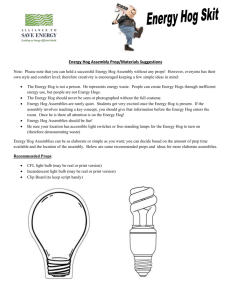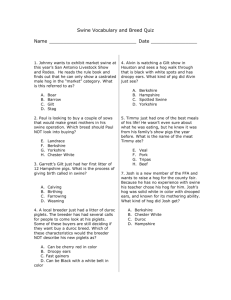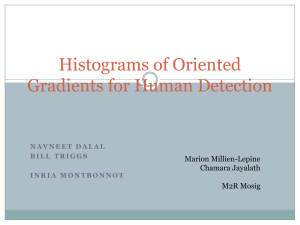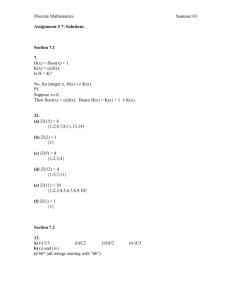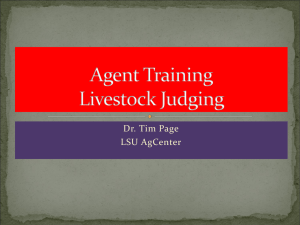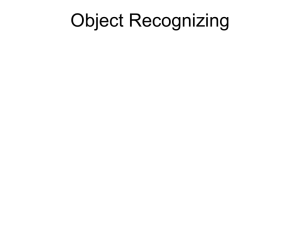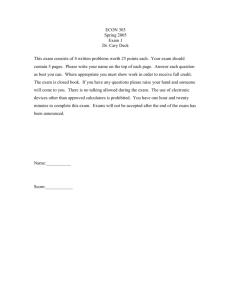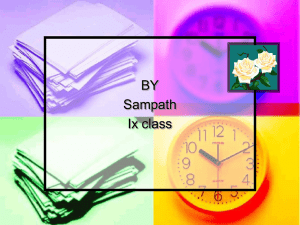ESCI-KSP Submission Form
advertisement
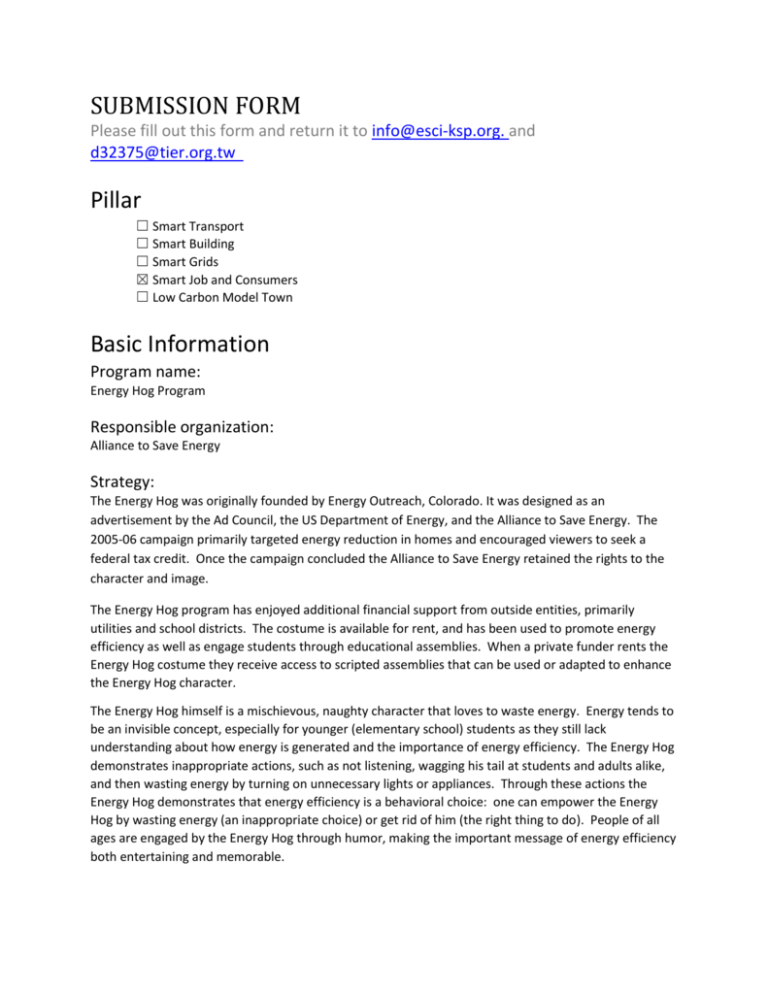
SUBMISSION FORM Please fill out this form and return it to info@esci-ksp.org. and d32375@tier.org.tw Pillar ☐ Smart Transport ☐ Smart Building ☐ Smart Grids ☒ Smart Job and Consumers ☐ Low Carbon Model Town Basic Information Program name: Energy Hog Program Responsible organization: Alliance to Save Energy Strategy: The Energy Hog was originally founded by Energy Outreach, Colorado. It was designed as an advertisement by the Ad Council, the US Department of Energy, and the Alliance to Save Energy. The 2005-06 campaign primarily targeted energy reduction in homes and encouraged viewers to seek a federal tax credit. Once the campaign concluded the Alliance to Save Energy retained the rights to the character and image. The Energy Hog program has enjoyed additional financial support from outside entities, primarily utilities and school districts. The costume is available for rent, and has been used to promote energy efficiency as well as engage students through educational assemblies. When a private funder rents the Energy Hog costume they receive access to scripted assemblies that can be used or adapted to enhance the Energy Hog character. The Energy Hog himself is a mischievous, naughty character that loves to waste energy. Energy tends to be an invisible concept, especially for younger (elementary school) students as they still lack understanding about how energy is generated and the importance of energy efficiency. The Energy Hog demonstrates inappropriate actions, such as not listening, wagging his tail at students and adults alike, and then wasting energy by turning on unnecessary lights or appliances. Through these actions the Energy Hog demonstrates that energy efficiency is a behavioral choice: one can empower the Energy Hog by wasting energy (an inappropriate choice) or get rid of him (the right thing to do). People of all ages are engaged by the Energy Hog through humor, making the important message of energy efficiency both entertaining and memorable. It is important to note that the Energy Hog assemblies are most successful when the character is accompanied by another human character: the Energy Hog Buster. This is the voice of the assembly as the Energy Hog himself does not speak due to costume limitations. This addition of the Energy Hog Buster is a creation of the Alliance to Save Energy, and enables assembly participants to see themselves in the role, therefore being empowered to “defeat” the naughty, energy-wasting Energy Hog. Clear understanding of the Energy Hog character comes from the website: www.energyhog.org. The Energy Hog has been a stand-out character because he represents energy waste, rather than more common mascots who represent savings. This allows those interacting with the Energy Hog to become the heroes (Energy Hog Busters) rather than more passive participants who simply agree with the ideas represented by a savings-oriented character. Additionally, the www.energyhog.org website features simple video games for students to play. This further engages students through the power of gaming; though the current games are simple flash games, students still enjoy defeating the Energy Hog and his various companions. Students focus on defeating the Energy Hog and in so doing learn the importance of energy efficiency. This also allows participation from students who are not able to enjoy and Energy Hog assembly, broadening the reach of the program. There are additional resources on the website, including a downloadable Energy Hog Scavenger Hunt educational tool for teachers with workbooks for students. These are available currently in English and Spanish, and are available at no cost to interested participants. Each year, the Energy Hog assembly is updated and enhanced to align with current educational needs and best practices. Since the character does not speak he is well suited to any audience without language barriers, though it should be noted that his jacket, reading “Energy Hogs Rule” is currently in English. The Energy Hog Buster, as the person delivering energy efficiency information, can be anyone. Scripts are currently being translated into Spanish, and can be made available in the language of the renter’s choice. In 2013 students engaged in the Alliance to Save Energy’s PowerSave Campus program opted to use the Energy Hog as part of their outreach program. The campus program engages students in college/university settings to promote energy efficiency on their campuses and in the community. These university students created their own assemblies and brought them to areas schools who wouldn’t otherwise have the opportunity to see an Energy Hog assembly due to funding restraints. Also in 2013 Kindergarten students in 14 different schools in Pittsburgh, PA enjoyed energy efficient lessons revolving around the Energy Hog concepts; they did not experience an assembly but instead were introduced to the Energy Hog through on-line coloring pages and the Energy Hog Scavenger Hunt booklets and on-line games as well as through original lessons. Measure: Since the Energy Hog successfully engages student’s imaginations he has been the catalyst for other educational opportunities as well. Students have created posters using digital art techniques, have written him letters, and in 2014 a pilot Energy Hog Writing Competition was successfully completed within an elementary school with 80% of the teachers opting into the competition. Students wrote about the Energy Hog as a character or about the importance of energy savings in whatever method they were currently being taught; for example, creative writing, persuasive letters, or simple statements using complete sentences. In 2015 the Energy Hog in one school district will be used to educate students on weatherization as it relates to energy efficiency of the home. This will encourage students to take concepts home and help families understand how to take control of their utility bills through simple weatherization best practices and understand of the building envelope. As the Energy Hog exists to inspire students either through simple games, assemblies, or downloadable materials, it is both cost-effective for districts and easily translated into other languages, making him suitable for any audience in any country. It is the idea of energy waste that is represented by the Energy Hog, and the fact that as the literal face of energy waste, making difficult to see or invisible concepts such as energy efficiency concrete, that makes the Energy Hog a successful tool. The Alliance’s PowerSave Schools program, of which the Energy Hog is part, does attest to the power of behavior change and energy savings, with 511 schools savings over 38,000MWh over the course of five years, which averages to between 5 and 15% reduction per school. However, there was a case in 2012 when a school using only the Energy Hog as a program had their energy consumption tracked by the school district through Portfolio Manager. In this case study, students engaged in an Energy Hog Assembly and then were challenged to monitor their school’s energy consumption. The students watched for three things that could be monitored without intruding into a classroom and possibly disrupting instructional time: whether lights were on when the classroom was empty, whether TVs were left on (a common practice in this particular school) and if doors and/or windows were open. Students would write tickets for those classrooms caught “creating Energy Hogs” by wasting energy, and they tracked the classrooms on a chart posted in a hallway. The results were that the school, through correcting these simple behaviors, reduced their energy consumption by nearly 24% (according to the energy management in the district). The school did not receive any retrofits or other energy-reducing services throughout the year. While this level of behavior change savings is very high, other schools have experienced similar savings numbers, demonstrating the power of students’ ability to generate change in their school if properly motivated. Equally important to the measured energy savings was the effect on the students. It is the goal of every school to inspire students to take knowledge home and apply their education in practical ways. Dozens of parents in the case study school alone commented on how their children were turning off lights and appliances while instructing their families about the importance of removing the Energy Hogs (Energy Hogs are not described as people but rather things that waste energy, such as lights or appliances left on when no person is present). To date there have been few metrics associated with the Energy Hog program. The Energy Hog Facebook page has only 1100 likes while videos on the Energy Hog YouTube page (www.youtube.com/user/MrEnergyHog) has many thousands of likes. In 2014-15 the Energy Hog costume was also rented by New Jersey Natural Gas (renting the costume since 2010) and Alaska Energy Authority (2013-2014), both using the costume to engage students within their states, and there have been other renters for similar purposes, such as Reading School District (PA, 2013), Eastern Iowa Community College District (2011-12), and Wood County Electric Cooperative (TX, 2011), as well as for special events such as the Children’s Museum of Indianapolis Energy Summit (2011) and the National Guard “Take You Child to Work Day” (MD, 2012-14). As the Energy Hog is both a stand-alone program and part of the PowerSave Schools program it will be available for many years. The character is also one that can be updated. Recently the Energy Hog costume received dark glasses to freshen his look, and the assemblies are updated annually to reflect current trends in education and emphasize STEAM (science, technology, engineering, arts, and math). Performance: Other evidence of the Energy Hog’s power to motivate students to reduce energy consumption has been anecdotal. Stories of students vigilantly watching for lights left on when teachers leave classrooms and of parents asking why their children are turning lights and appliances off at home to “remove the Energy Hogs” abound. Testimonials include: “The Energy Hog accomplished more than we could have ever explained,” (Jackie Jinks, Utility Conservation Director); “the Energy Hog gets the energy efficiency message across to students, faculty, and staff in a way that they remember and talk about to their friends and families,” (Vince Meyer, school district Energy Educator); “students from Kindergarten to sixth grade were taking about how great the assembly was and how much they learned,” (Suzanne Adame, First Grade teacher). Data to support the Energy Hog’s emissions reduction is listed in the Measure section. In addition, the Energy Hog is demonstrating success through its increasing popularity. In 2009 there were very few assemblies requested. However, in 2010 the assembly scripts were updated and the new Energy Hog website was designed. These simple face-lifts to the program increased demand for assemblies and the Energy Hog dramatically. In 2012-14 one school district focused educational efforts on the Energy Hog, providing assemblies and encouraging the 8,000+ students to participate in Energy Hog Tag, a game developed for the case student outlined in the Measurement section and demonstrated on the energyhog.org website getting students to monitor simple energy-savings behavioral choices. The school district believed in the power of the Energy Hog and the educational benefits combined with energy savings enough to devote $46,400 into the two-year program development. In 2014-15 there were over 50 assemblies engaging over 15,000 students. The Energy Hog continues to inspire. In 2015 an aspiring “environmental hip-hop star”, Mr. Eco, created an original song around the Energy Hog, which he will used in his performances encouraging energy efficiency, and the Energy Hog YouTube website (www.YouTube.com/energyhog) has a growing number of videos inspired by the character. As the Energy Hog is a character enhanced by the Hog Buster, his messaging can be effective in a variety of operational areas regarding energy use and weatherization best-practices. As stated in previous sections, while behavior change can be quantified it is difficult to isolate the specific impact of the Energy Hog alone on the field of energy efficiency and specifically with energy savings. However, as data does prove students inspired to save energy are extremely effective in promoting no-cost behavior change, and the anecdotal evidence, testimonials, and increasing demand for the Energy Hog demonstrates the character’s ability to provide that inspiration. APEC Economies: ☐ Australia ☐ Brunei ☐ Canada ☐ Chile ☐ China ☐ Chinese Taipei ☐ Hong Kong ☐ Indonesia ☐ Japan ☐ Korea ☐ Malaysia ☐ Mexico ☐ New Zealand ☐ Non-APEC Economy ☐ Papua New Guinea ☐ Peru ☐ Philippines ☐ Russia ☐ Singapore ☐ Thailand ☒ United States ☐ Viet Nam Additional Project Details Image: Upload: Fountain City 4 grade winner 2015 and YouTube video link. Website: www.energyhog.org Contact Information Contact Name: Jennifer Alldredge Contact Email: jalldredge@ase.org
